 |
FACTORY OVERHEAD COST:Marketing, Research and development |
| << ALLOCATION AND APPORTIONMENT OF FOH COST |
| FACTORY OVERHEAD COST:Spending Variance, Capacity/Volume Variance >> |
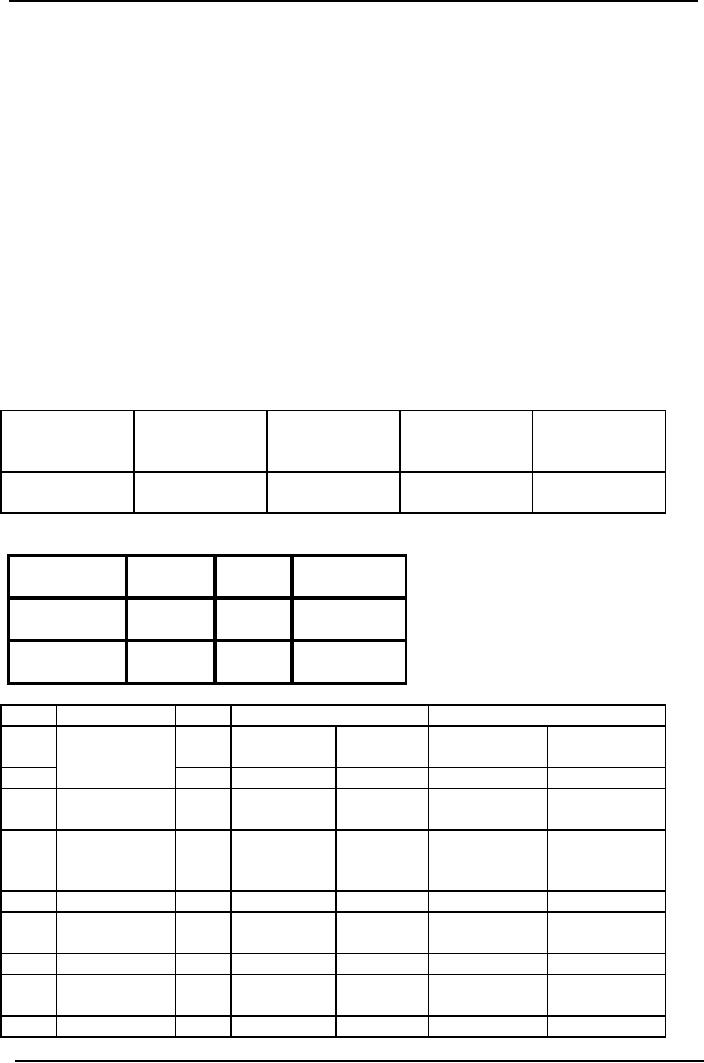
Cost
& Management Accounting
(MGT-402)
VU
LESSON
# 16
FACTORY
OVERHEAD COST
(Apportionment
& Variance Analysis)
Reciprocal
Apportionment
This
method recognizes the fact
that if a service department
receives from other service
e
department,
the department receiving services
should be charged. Thus the
costs of
interdepartmental
services are taken into
account on reciprocal basis.
There
are two main methods
which may be used for
reciprocal distribution:
1.
Repeated distribution
method
2.
Algebraic method
Repeated
distribution method
Under
this method, the total of
overhead costs of the
service departments are distributed to
other
service
and product ion department
according to the given percentage
till the expense of all
service
departments
are exhausted or remains
insignificant.
PRACTICE
QUESTION
Following
is the cost of summary of
allocated indirect cost of an
organization
Machining
Finishing
Maintenance
Air-conditioning
Allocated
indirect
cost
100,000
70,000
40,000
30,000
240,000
The
above costs of service departments
are apportioned among the
departments in the following
ratios.
Machining
Finishing
Air-
conditioning
Maintenance
60%
15%
25%
Appropriation
Air
70%
25%
5%
Conditioning
Production
Service
Machining
Finishing
Maintenance
Air-
Allocate
conditioning
Indirect
cost
Rs.
240,000
100,000
70,000
40,000
30,000
Maintenance
24,000
6,000
(40,000)
10,000
Air-
28,000
10,000
2,000
(40,000)
conditioning
Maintenance
1200
300
(2,000)
500
Air-
350
125
25
(500)
conditioning
Maintenance
15
3.50
(25)
6.50
Air-
5
1.50
0.50
(6.50)
conditioning
153,570
86,430
108
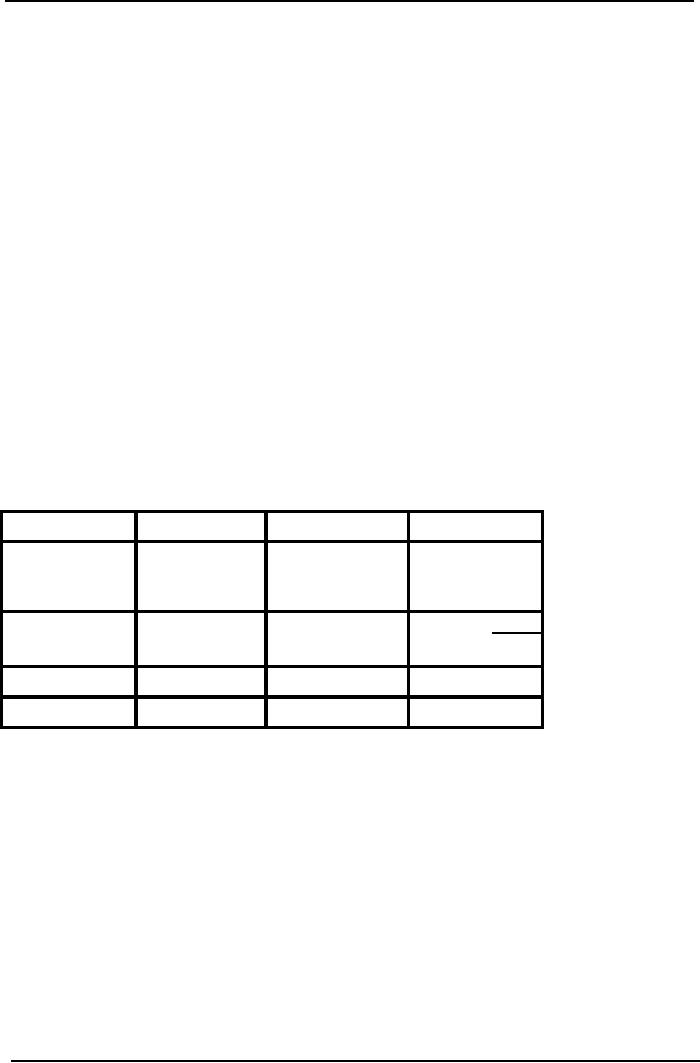
Cost
& Management Accounting
(MGT-402)
VU
Solution
(Algebraic method)
Maintenance
Dept
=X=
(40,000)+5%
of Air condition
Air
conditioning Cost
=Y=
(30,000)+25%
of maintenance
X
=40,000+5% of y
X
= 30,000 + 25% of x
X
=40,000+0.05(30,000+0.25x)
X
=40,000+1500+0.0125x
X
=0.0125x = 41,500
0.9875x
= 41,500
X
= 41,500
0.9875
Cost
of Maintenance Dept
X
= 42,025
Y
= 30,000 + 25% of x
Y
= 30,000 + 0.25 (42,025)
Y
= 30,000 +10,506 = 40,506
Y
= 40,506
Apportionment
Machinery
Finishing
Maintenance
Air-condition
1,00,000
70,000
40,000
30,000
(42,025)
25,215
6,304
2,025
10,506
(40,506)
28,354
10,127
2,025
40,506
1,53,569
86,431
0
0
Over/under-absorption
of overhead
In
the previous LESSON s
reference was made to an
accounting problem associated
with the use
of
predetermined absorption rates.
Where
the amount of overhead
absorbed exceeds the actual
overhead cost incurred, the
excess is
known
as over-absorption; if the amount
absorbed is less than the
cost incurred then
the
difference
is know as under-absorption.
Accounting
for over/under
absorptions
The
extent of any over/under-absorption is a
balancing figure in the
production overhead account.
This
is normally transferred to the costing
profit and loss account
each month. Though it may
be
carried
forward in the production
overhead account until the
end of the year when any
net
over/under-absorption
for the year is transferred
to profit and loss account.
This treatment, it is
argued,
is reasonable because the predetermined
absorption rate is based on
annual costs and
activity
levels.
109
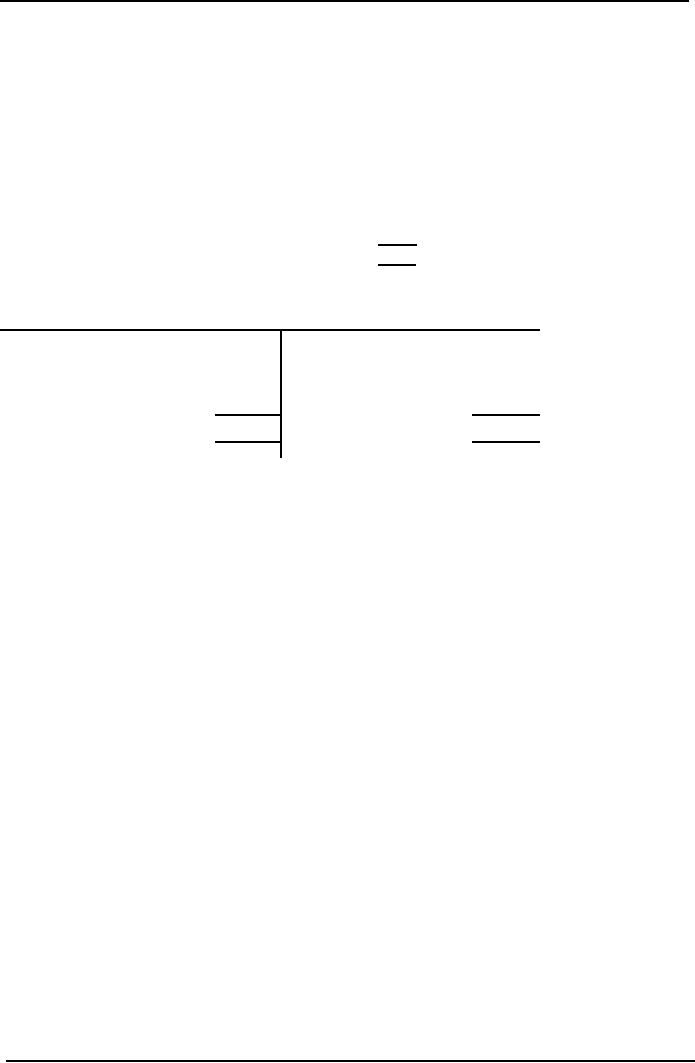
Cost
& Management Accounting
(MGT-402)
VU
PRACTICE
QUESTION
Q.
1
From
the following data calculate
the over/under absorption
and show how the
transactions
would
be recorded in the production
overhead account.
Absorption
rate
=
Rs.5.00 per direct labor
hour
Number
of direct labor hours =
1,400
Production
overhead incurred = Rs.
6,900
Solution
Rs.
Production
overhead absorbed =
Rs.5.00
x 1,400
7,000
Production
overhead incurred
6,900
Over-absorption
100
Production
overhead account
Rs.
Rs.
6,900
Work-in-progress
7,000
Creditors
100
Balance
(over-absorption)
7,000
7,000
Q.
2
From
the following data relating to
four departments of a factory you
are required to:
(a)
Journalize departmental overheads
incurred
(b)
Journalize departmental overheads
recovered
(c)
Give the journal entry
recording
under or over-absorbed overhead
expenditure.
Actual
expenses
Absorption
rates (based on pre-determined
Rs.
annual
estimates}
Department
A
1,000
Rs.0.10
per machine hour
Department
B
4,000
Rs.0.75
per direct labor hour
Department
C
7,000
100%
on direct wages
Department
D
3,500
Rs.0.25
per unit
Machine
Direct
Direct
wages
Units
produced
hours
worked
labor
hours
·worked
Rs.
Department
A
10,000
11,000
6,000
100,000
Department
B
3,000
5,300
6,000
48,900
Department
C
6,000
18,000
6,800
52,000
Department
D
14,000
30,000
10,000
13,800
110
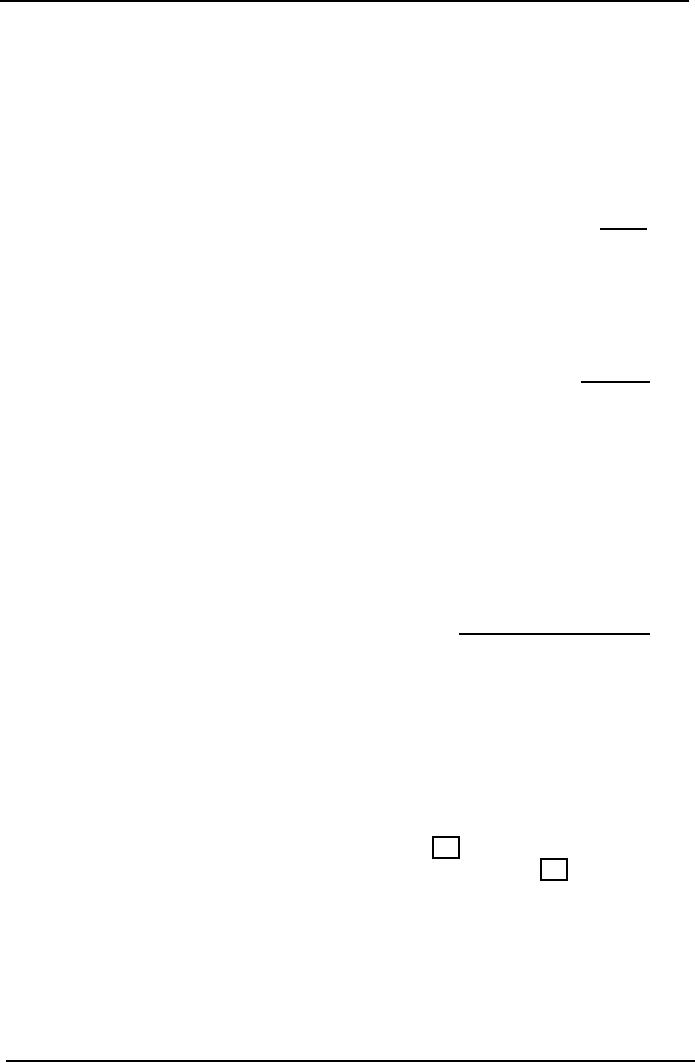
Cost
& Management Accounting
(MGT-402)
VU
Solution
(a)
Departmental overheads
incurred.
Dr
-
Cr
Rs.
Rs.
Department
A overhead account
1,000
Department
B overhead account
4,000
Department
C overhead account
7,000
Department
D overhead account
3,500
Factory
overhead control
account
15,500
Transfer
of actual departmental expenses
15,500
15,500
for
period
(b)
Departmental overheads
recovered
Dr
Cr
Rs.
Rs.
Work
in progress account
15,225
Department
A overhead account
1,000
Department
B overhead account
3,975
Department
C overhead account
6,800
Department
D overhead account
3,450
Transfer
of absorbed departmental expenses for
period
15,225
15,225
(c)
Under- or over-absorbed overhead
expenditure
Dr
Cr
Rs.
Rs.
Profit
and loss account
275
Department
B overhead account
25
Department
C overhead account
200
Department
D overhead account
50
275
275
Transfer
of under-absorbed departmental expenses for
period
(c)
Under or over-absorbed overhead
expenditure
Department
A
10.000
machine hours x Rs.0.10
1,000
Department
B
5.300
labor hours x Rs.0.75
3,975
Department
C
100%
of Rs.6.800
6,800
Department
D
13,800
units x Rs.0.25
3,450
111

Cost
& Management Accounting
(MGT-402)
VU
If
predetermined
absorption
rates
are used. It is likely that
there
will be under or over-absorption
of
overheads. This is
the
balance on the
production overhead account
and will be debited
or
credited
in the
costing profit
and
loss account.
Absorption
of non-production costs
Non-production
costs
are costs incurred
for non-manufacturing reasons such as
administration
or
selling and marketing cost.
The
cost
of
administration,
marketing,
research
and development
etc.
has a great
impact
on
the
fortunes
of a business,
and
thus must be allowed for in
cost-per-unit. Calculations which
provide
information
for cost control and
disclose the
effect
of
management
decisions
on other function
costs,
and
vice
versa.
Marketing
Marketing
comprises
the activities of selling, publicity and
distribution.
The
cost accounting system
should show:
·
Suitable cost centre analysis to
identify costs with
responsibility
·
Analysis between fixed and
variable, especially for
distribution costs, e.g.
packaging and
delivery
·
Statistical bases to measure
and compare costs,
e.g.
salesmen's calls, number of
orders
General
administration
General
administration
represents the costs of
general management, secretarial
accounting and
administrative
services except for any such
costs which can be directly
related to production,
marketing,
research or development.
Once
again the cost accounting
emphasis will be on analysis by
cost centre for
control.
Research
and development
Research
costs are those incurred in
seeking new or improved
products or methods. Development
costs
are those incurred by those stages
from decision implementation to
production.
Cost
analysis will usually relate
to natural classification, such as
materials or laboratory services
and
will
accumulate costs by specific
project.
Attributing
non-production costs to output
IAS
2 regulates the valuation of
stocks and work-in-process
for financial accounting
purposes and
states
that only production costs
should be included in stock valuations.
This defeat the
argument
for
attributing non-production costs to
output. However, as has been
stated above, such costs
are
often
significant, and their
inclusion in internal unit
costs may be necessary in
order to ensure that
they
are fully recognized in any
pricing policy discussions
undertaken by management
accountants.
For
pricing purposes the most
common method of attributing
non-production costs to
output
units
is by an absorption rate calculated as a
percentage of production cost.
The alternative to this
is
to treat non-production overheads as period
costs and write them
off in full as an expense of
the
period
in which they are incurred,
with no absorption into
units produced in the period.
Multiple
Choice Questions
1
The
following statements relate to
the effects or advantages of using a predetermined
overhead
absorption
rate, rather than calculating
overhead costs on the basis
of actual costs and
actual
activity
levels.
112

Cost
& Management Accounting
(MGT-402)
VU
(a)
IAS 2 requires the
absorption of production overhead to be
based on normal levels
of
activity
rather than actual levels of
activity.
(b)
Using a pre-determined absorption
rate avoids fluctuations in
unit costs caused by
abnormally
high or low overhead
expenditure or activity
levels.
(c)
The net profit each
year, allowing for the
under- or over-absorbed overhead
adjustment
to
profit, will be the same
with pre-determined overhead rates as
with actual rates.
(d)
Using a pre-determined absorption rate
offers the administrative convenience
of
being
able to record full production
costs sooner.
All
of these statements are
correct except:
A.
Statement
(a)
B.
Statement
(b)
C.
Statement
(c)
D.
Statement
(d)
2
What
is cost apportionment?
A.
The
charging of discrete identifiable items
of cost to cost centers or
cost units
B.
The
collection of costs attributable to
cost centers and cost
units using the costing
methods,
principles and techniques prescribed for
a particular business
entity
C.
The
process of establishing the
costs of cost centers or
cost units
D.
The
division of costs amongst two or
more cost centers in
proportion to the
estimated
benefit
received, using a proxy, e.g.
square feet
3
Grumpy
& Dopey Ltd estimated
that during the year
75,000 machine hours would be
used
and
it has been using an overhead
absorption rate of Rs.6.40
per machine hour in its
machining
department. During the year
the overhead expenditure
amounted to Rs.472,560
and
72,600 machine hours were
used.
Which
one of the following statements is
correct?
A.
Overhead
was under-absorbed by Rs.7,440
B.
Overhead
was under-absorbed by Rs.7,920
C.
Overhead
was over-absorbed by
Rs.7,440
D.
Overhead
was over-absorbed by
Rs.7,920
PROBLEM
QUESTION
You
are the cost accountant of
an industrial concern and
have been given the
following
budgeted
information regarding the
four cost centers within
your organisation.
You
also ascertain the following
points:
(i)
The canteen staff is outside
contractors.
(ii)
Departments 1 and 2 are
production cost centers and
the Maintenance department
and
Canteen
are service cost
centers.
(iii)
The Maintenance department provides 4,000
service hours to Department 1
and 3,000 service
hours
to Department 2
(iv)
Department 1 is machine-intensive and
Department 2 is labor-intensive.
(v)
6,320 machine hours and
7,850 labor hours are
budgeted for Departments 1
and 2 respectively
for
2006.
Required
Prepare
an overhead cost statement showing
the allocation and
apportionment of overhead to
the
four
cost centers for the
year 2006, clearly showing
the basis of apportionment.
Consider the
following
given information:
113
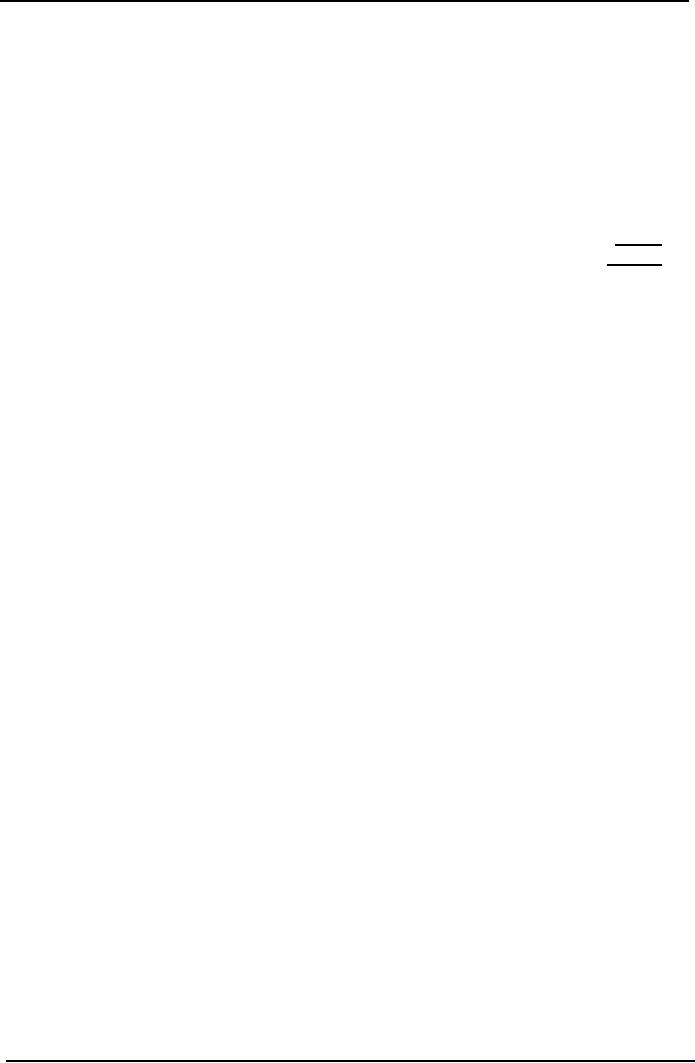
Cost
& Management Accounting
(MGT-402)
VU
Dept
1
Dept
2
Maint-
Canteen
Total
enance
Rs.
Rs.
Rs.
Rs.
Rs.
Indirect
labor
60,000
70,000
25,000
15,000
170,000
Consumables
12,000
16,000
3,000
10,000
41,000
Heating
and lighting
12,000
Rent
and rates
18,000
Depreciation
30,000
Supervision
24,000
Power
20,000
315,000
You
are also given the following
information:
Dept
1
Dept
2
Mainte
Canteen
Total
dept
Floor
space in
10,000
12,000
5,000
3,000
30,000
square
meters
Book
value of
150,000
120,000
20,000
10,000
300,000
machinery
in Rs
Number
of employees
40
30
10
80
Kilowatt
hours
4,500
4,000
1,000
500
10,000
114
Table of Contents:
- COST CLASSIFICATION AND COST BEHAVIOR INTRODUCTION:COST CLASSIFICATION,
- IMPORTANT TERMINOLOGIES:Cost Center, Profit Centre, Differential Cost or Incremental cost
- FINANCIAL STATEMENTS:Inventory, Direct Material Consumed, Total Factory Cost
- FINANCIAL STATEMENTS:Adjustment in the Entire Production, Adjustment in the Income Statement
- PROBLEMS IN PREPARATION OF FINANCIAL STATEMENTS:Gross Profit Margin Rate, Net Profit Ratio
- MORE ABOUT PREPARATION OF FINANCIAL STATEMENTS:Conversion Cost
- MATERIAL:Inventory, Perpetual Inventory System, Weighted Average Method (W.Avg)
- CONTROL OVER MATERIAL:Order Level, Maximum Stock Level, Danger Level
- ECONOMIC ORDERING QUANTITY:EOQ Graph, PROBLEMS
- ACCOUNTING FOR LOSSES:Spoiled output, Accounting treatment, Inventory Turnover Ratio
- LABOR:Direct Labor Cost, Mechanical Methods, MAKING PAYMENTS TO EMPLOYEES
- PAYROLL AND INCENTIVES:Systems of Wages, Premium Plans
- PIECE RATE BASE PREMIUM PLANS:Suitability of Piece Rate System, GROUP BONUS SYSTEMS
- LABOR TURNOVER AND LABOR EFFICIENCY RATIOS & FACTORY OVERHEAD COST
- ALLOCATION AND APPORTIONMENT OF FOH COST
- FACTORY OVERHEAD COST:Marketing, Research and development
- FACTORY OVERHEAD COST:Spending Variance, Capacity/Volume Variance
- JOB ORDER COSTING SYSTEM:Direct Materials, Direct Labor, Factory Overhead
- PROCESS COSTING SYSTEM:Data Collection, Cost of Completed Output
- PROCESS COSTING SYSTEM:Cost of Production Report, Quantity Schedule
- PROCESS COSTING SYSTEM:Normal Loss at the End of Process
- PROCESS COSTING SYSTEM:PRACTICE QUESTION
- PROCESS COSTING SYSTEM:Partially-processed units, Equivalent units
- PROCESS COSTING SYSTEM:Weighted average method, Cost of Production Report
- COSTING/VALUATION OF JOINT AND BY PRODUCTS:Accounting for joint products
- COSTING/VALUATION OF JOINT AND BY PRODUCTS:Problems of common costs
- MARGINAL AND ABSORPTION COSTING:Contribution Margin, Marginal cost per unit
- MARGINAL AND ABSORPTION COSTING:Contribution and profit
- COST – VOLUME – PROFIT ANALYSIS:Contribution Margin Approach & CVP Analysis
- COST – VOLUME – PROFIT ANALYSIS:Target Contribution Margin
- BREAK EVEN ANALYSIS – MARGIN OF SAFETY:Margin of Safety (MOS), Using Budget profit
- BREAKEVEN ANALYSIS – CHARTS AND GRAPHS:Usefulness of charts
- WHAT IS A BUDGET?:Budgetary control, Making a Forecast, Preparing budgets
- Production & Sales Budget:Rolling budget, Sales budget
- Production & Sales Budget:Illustration 1, Production budget
- FLEXIBLE BUDGET:Capacity and volume, Theoretical Capacity
- FLEXIBLE BUDGET:ANALYSIS OF COST BEHAVIOR, Fixed Expenses
- TYPES OF BUDGET:Format of Cash Budget,
- Complex Cash Budget & Flexible Budget:Comparing actual with original budget
- FLEXIBLE & ZERO BASE BUDGETING:Efficiency Ratio, Performance budgeting
- DECISION MAKING IN MANAGEMENT ACCOUNTING:Spare capacity costs, Sunk cost
- DECISION MAKING:Size of fund, Income statement
- DECISION MAKING:Avoidable Costs, Non-Relevant Variable Costs, Absorbed Overhead
- DECISION MAKING CHOICE OF PRODUCT (PRODUCT MIX) DECISIONS
- DECISION MAKING CHOICE OF PRODUCT (PRODUCT MIX) DECISIONS:MAKE OR BUY DECISIONS